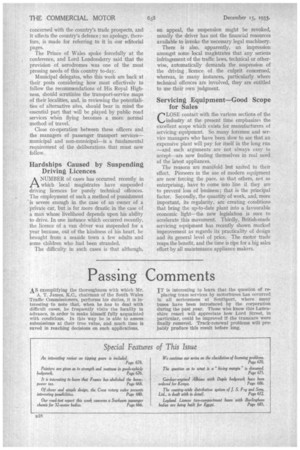Passing Comments
Page 36

Page 37

If you've noticed an error in this article please click here to report it so we can fix it.
AS exemplifying the thoroughness with which Mr.
A. T. James, K.C., chairman of the South Wales Traffic Commissioners, performs his duties, it is interesting to note that, when he has to deal with difficult cases, he frequently visits the locality in advance, in order to make himself fully acquainted with conditions. In this way he is able to assess submissions at their true value, and much time is saved in reaching decisions on such applications.
IT is interesting to learn that the question of replacing tram services by motorbuses has occurred in all seriousness at Southport, where many buses have been introduced by the corporation -during the past year. Those who know this Lancashire resort will appreciate how Lord Street, in particular, could be improved if the tramcars were finally removed. Track-renewal problems will proably produce this result before long.
LANCASHIRE travellers by road are learning about the side-engined Q-type city bus which the A.E.C. concern exhibited at the Olympia Show last month, and the comments are reported to be favourable. 13oiton Corporation has put a Q-type into service, and is claimed to be the first Lancashire municipality to do so.
IN a paper which he read before a sectional
meeting, in Scandinavia, of the World Power Conference, Mr. Thor Lange asserted that tile starting and acceleration of buses with hydraulic transmission systems were more flexible than in trolleybuses. Moreover, he thought that the repair costs, resultant upon engine vibration and jolting, should be no greater for such a bus than for the electric type.
IF horsed carts cannot economically be abandoned at present, the next best move is to modernize them by equipping them with pneumatic tyres. This fact has been realized at Cardiff, where all the municipal horse-drawn refuse collectors are to be mounted upon pneumatics. It has been found that such tyres give lower loading weight and ease the tractive effort. No difficulty has been experienced at the refuse tips during the experimental operation of this horsed collector on pneumatics.
THE London transport authority is out to disprove the cynical statement, sometimes made in connection with transport, that what the provinces do to-day, London does to-morrow. Some 90 miles of tramways are proposed to be converted to trolleybus operation, with a consequent speeding-up of traffic, less congestion and, it Is to be hoped, a reduction in the number of road accidents. Incidentally, it is interesting to recall that about a year ago, the London tramways were regarded as having many years of life before them. AT the various company meetings that have taken place of late, quite an optimistic note has prerailed, and on all sides a decided improvement in trade has been reported during the past few weeks. The orders for *one or two vehicles that have dribbled through for many, many months have given way to indents for substantial fleets, now that the period of uncertainty, brought about by impending legislation, has passed. This healthy reawakening once again proves that the commercial-vehicle industry is far from being moribund.
ONE of the most interesting of shows is that per
manently held by ThoMas Parsons and Sons, Ltd., 315, Oxford Street, London, W.1. This company is always keen on staging the most modern exhibits, of which the latest is the A.E.C. sectioned four-cylindered oil engine, in which the various parts can be seen in operation, being electrically
driven. It is particularly appropriate that this power unit should be shown beside the route upon which operates the majority of A.E.C. oil-engined buses run by London Transport.
SPEAKING at a recent Olympia conference, a rail way engineer remarked that the electric lighting set was an elaborate and costly unit for its relatively easy duties. Considering its power output—a relatively small fraction of an electrical horse-power —his statement at first sight seems reasonable, but what may be paid for in complexity of design is certainly recovered in simplicity of usage. The mechanism of the primitive oil lamp, held as a desirable alternative, was well within the comprehension of our grandmothers, but its inefficiency, unreliability, and need for frequent attention render it a very bad second. Furthermore, it is hardly adequate for work in poorly lit streets, yards, docks, etc., whilst an electric installation is useful for many other purposes besides lighting.




































































































